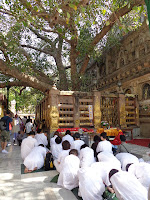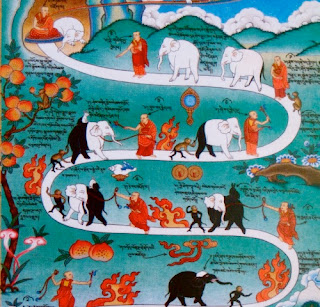I just read the latest review for Nylas Book and want to pass it on as many of you may be able to use her work in your research or to expand your personal knowledge. I had mentioned the book in previous posts, so here is the latest review.
The Parchment of Kashmir gathers together a wide range of essays on the subject of Kashmir. It is a compelling and stimulating book for a number of reasons. First, it interrelates a range of disciplines from political science and sociology to history, philosophy, and English. Second, it is produced by academics, all of whom are based in Jammu and Kashmir. Third, because these essays are written by scholars who are intimate with Kashmir, yet have not had an opportunity to be read outside of local circles, the book gives them a readership that they otherwise wouldn’t have; but readers themselves also benefit because the essays provide them with a view that is genuine and local and that otherwise would have been obscured.
The book comprises an introduction and nine chapters, each authored by different scholars. Therefore, it seems appropriate to structure this review according to their separate contributions. As with any such collection of essays, there is, of course, an element of repetition. But, broadly speaking, the essays follow a chronological trajectory, passing from the personal, through the spiritual, to the practical, and then back to the personal. The book is demarcated by sections which group the essays under such subjects as identity andKashmiriyat, cultural syncretism, sovereignty and democratic governance, conflict, and knowledge production.
Nyla Ali Khan, the editor, who currently teaches at the University of Oklahoma and has written extensively on Kashmir (most recently, Islam, Women, and Violence in Kashmir: Between India and Pakistan, Tulika Books, 2009; Palgrave Macmillan, 2010; Gulshan Books, 2011), begins her Introduction with a general look at Kashmir, focusing next upon issues of history, nation, culture, and misfortune. Noteworthy is Khan’s insistence on the heterogeneity of Kashmiri identity and history, her refusal to sentimentalize aspects of cultural loss (such as the loss of Kashmiriyat), and her emphasis on ‘analyses of subjectivity’, which makes possible her own emphasis on women’s roles and identity in the context of cultural and political upheaval. In Khan’s words: ‘Narrative structures in this work are constituted by the variables of race, gender, education, marital status, social class, and nationality, which generate complex conventions and relations of power’ (p. 7). The result of this diversity of personal and ideological backgrounds is a richness that cannot be reduced to a monolithic truth about Kashmir.
The first chapter, ‘Evolution of my identity vis-à-vis Islam and Kashmir’, by Mohammad Ishaq Khan, provides an effective opening by examining personal identity and opinions in the historical environment of Kashmir. Most important, key terms are introduced, includingKashmiriyat, jihad, rishis, Sufis, and azadi. All are examined from the personal viewpoint so that, for example, jihad is thought of as the war against one’s baser self. The essay concludes with an appeal to the higher, unifying logic of spiritual nonviolence.
Continuing the discussion of Kashmiriyat, the second essay, ‘Kashmiriyat: The Voice of the Past Misconstrued’, by Rattan Lal Hangloo, historicizes this ethos of Kashmiriness, viewing it not merely as a concept but as a many-layered, syncretic cultural and secular institution. This essay is, in many ways, the most fundamental contribution in that it examines Kashmiriyat in detail, its development and change over time. Hangloo views Kashmiriyat as unique to Kashmir as a result of geography, ecology, religion, and culture, although it has imbibed influences from neighbours. He concludes with a useful discussion of the partial erosion of Kashmiriyat in terms of diaspora and the geopolitics of the Cold War.
Chapter three builds upon the previous contribution in that it examines both Muslim and Hindu approaches to Kashmiriyat. But M.H. Zaffar’s inspirational essay on the spiritual nature of Kashmir prioritizes ‘an un-indoctrinated folk approach’ (p. 71) as it looks in turn at Buddhism, Saivism, and Sufism. The whole is further enlightened by wonderful selections from the poetry of Lal-Ded and Nund Rishi.
Neerja Mattoo’s essay complements Zaffar’s in bringing the Sufi and Saiva traditions together as a symbiotic entity. Mattoo discusses the poetry of Lal-Ded, Nund Rishi, Shah Ghafoor, and Rupa Bhavani to show how the Muslim and Hindu mystical traditions fuse to form a common worship of the Divine.
The following four chapters take a pragmatic turn, beginning with Noor Ahmad Baba’s ‘Democracy and Governance in Kashmir’, which introduces the more practical elements in an examination of democracy and government. In the conflict between two states over governance, the Kashmir Valley in particular has suffered, leaving a politically bereft community and laying waste to the potential of a true democracy, defined here as ‘the empowerment of people, ensuring rule of law and guaranteeing rights and securities fundamental for living a good life’ (p. 106). Sheikh Mohammad Abdullah’s re-election in 1975 paved the way for decentralization through local governance with the adoption of the Panchayati Raj Act of 1989; unfortunately, these sound initiatives were squandered as the Jammu and Kashmir region grew increasingly militant and divisive. The key point made by Baba is that there are not simply two states that are involved; this simplistic view completely disregards the will of the people and produces politico-institutional distortions.
Gull Mohammad Wani’s essay, ‘Political Assertion of Kashmiri Identity, follows naturally from Baba’s while taking up the thread begun by Hangloo on the subject of identity politics. Wani clarifies that the issues lie essentially between people, not in people. The idea of community is traced through history, from 1585 onward, and illustrates the gradual elimination of the Kashmiri self. Particular attention is paid to the spirit of nationalism and the drive for self-determination in the face of foreign aggression and oppression, and the secular ideology of Kashmiriyat is understood as the core element of Kashmiris, such as was embodied in the 1950s political mobilization led by Sheikh Mohammad Abdullah. Wani argues that the distinct identity of the Kashmiris is rooted in history and culture, but it also includes variables such as geography, economic viability, and iconography. While such a view has been inhibited by the differing thought processes of India and Pakistan and held back by global geopolitics, the essay remains optimistic about the prospects for regional governance.
Chapter seven investigates in more detail the historical links between Kashmiri and Indian nationalisms. These were not inimical in their aims – agrarian reform being one of the binding factors, secular democracy being another. However, over time and, in particular, with the ousting of Sheikh Mohammad Abdullah in 1953, the two came into conflict; Kashmir then became India’s ‘national interest’ and thus the two nationalisms became antagonistic. Of note in the essay is Rekha Chowdhary’s urging readers to consider what is left out of forms of nationalism that are univocal and monolithic: the will of the people themselves in all of their cultural diversity and genuine heterogeneity.
Bashir Ahmed Dabla’s essay, ‘Sociological Dimensions and Implications of the Kashmir Problem’, develops many of these ideas from the sociological viewpoint. Commendable is Dabla’s inclusion of his own personal experiences of the trauma and ravages wrought by the state of militarization and militancy in Kashmir. His premise is that Kashmiri identity is distinctive, affected by a wide range of factors including religion, ideology, politics, economics, sociology, culture, and psychology. With the active participation of academics, the distinctive Kashmiri perspective has been highlighted and reinforced by the growth of militancy. The author recognizes four phases over recent history: one, Kashmiri national fervour and progressive reforms; two, ambiguous democracy; three, mass election rigging; four, the insurrection of Kashmiri youth. Following this is a discussion on a range of broadly sociological problems, including demographic manipulation, economic backwardness, educational backwardness, violence against women, deviance and crime, and the effects of all of these, including discrimination against Kashmiris, cultural deprivation, mental and physical deterioration, corruption and militancy. Dabla concludes that there is a desperate need for social programmes and, in fact, complete social rehabilitation.
The book closes with a moving personal account of the politics of exclusion enforced by the Indian hegemonic state. From an early age, writes Hameeda Naeem, ‘I got passionately involved in thinking about the fate of my homeland, which paradoxically seemed to be my own, and yet very alien’ (p. 214). An education in postcolonial theory exposed Naeem to the politics of knowledge construction and the ideological functioning of the state, the manner in which the state coerced or manufactured consent to its regulation of every aspect of human life. Gross brutalities carried out by the Indian Army against people for demanding basic civic rights, several of whom included the author’s own family, galvanized Naeem into political activism. Not only the repressive forces of the government but the public media – ‘analyses of television debates; the invited panelists; write-ups in the national English and vernacular papers, magazines, and reports from the government agencies; and …reporting on the conflict by the national media’ (p. 220) – too bear responsibility for distorting facts and silencing minority voices. As a result, the history of Kashmir, both past and present, stands severely diminished, and children are brought up ‘almost rootless’ (p. 221).
In all, this collection of essays is a compelling tribute to the need for genuine democracy for Kashmir, one that will account for all of its voices, religions, languages, histories, and traditions. One must believe that the sharing of such views with other scholars, particularly in the Indian subcontinent, will produce some movement, if barely perceptible, towards a fuller understanding and a possible settlement of the Kashmir issue. Furthermore, the book provides an instructive framework for both theoreticians and practitioners who work on global minority issues which bears some resemblance to that of Kashmir. An obvious example which springs to mind and is located in at least four states is that of the Kurds. In Iraq, there is a clear Kurdish history, identity, and perspective and at the present time efforts are being made to delimit a boundary to the Kurdish area which takes into account the variables discussed in this book. The Parchment of Kashmir is a step in the direction toward a broader, yet deeper, knowledge of Kashmir as told by Kashmiris. More than this: to read its parchment is an invitation to extend our social and ethical thinking.
Alpana Sharma
Wright State University, Dayton


.jpg)

























